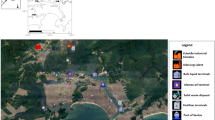Abstract
Potentially toxic metals tracked by the Arctic Monitoring and Assessment Program were analysed in sediments from the Svalbard western coastal zone. These include As and Hg found as contaminants in other Arctic seas as well as other elements (e.g. Pb, V, Cu, Zn, Cr, Ni). Svalbard shelf sediments contain average values of 12 ppm As, 12 ppm Pb, 56 ppb Hg and 114 ppm V. These values increase in Isfjorden sediments to 15 ppm As, 28 ppm Pb, 99 ppb Hg and 210 ppm V. Cluster analysis yields a major cluster that is likely related to clay minerals (Al, K, Ti, Mg) and sorption onto them of transition (Cu, V, Cr, Sc) and other elements (Pb, Rb). A second significant cluster includes Ca, Sr and plagioclase. The Svalbard western shelf is a natural geochemical environment. The possible incipient contamination of fjord sediments by As, Pb, Hg and V should be evaluated for possible links to anthropogenic sources. If links are found, remediation must be used to stop the input and preserve a pristine Svalbard fjord environment.
Similar content being viewed by others
Author information
Authors and Affiliations
Additional information
Received: 21 December 1998 · Accepted: 15 March 1999
Rights and permissions
About this article
Cite this article
Siegel, F., Galasso, J., Kravitz, J. et al. The Svalbard western coast: site of baseline geochemistry and incipient contamination. Environmental Geology 39, 816–822 (2000). https://doi.org/10.1007/s002540050498
Issue Date:
DOI: https://doi.org/10.1007/s002540050498




